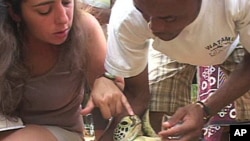Kenya's ocean waters are home to five out of the world's eight species of turtles. All are classified as either endangered or critically endangered, and are threatened by poaching, fishing nets, development and pollution. The conservation groups Watamu Turtle Watch and Funzi Island Turtle Club are striving to protect the turtles in Kenya.
There's a sense of joy in the evening, as newborn turtles wriggle out of their nest and waddle to the ocean to begin their lives. Members of a local conservation group, Watamu Turtle Watch, have been observing the nest for a couple of days. They stand by to make sure the hatchlings reach their destination.
Conservationists estimate that only about one percent of these hatchlings will make it to adulthood.
Andrew Wamukota heads the Kenya Sea Turtle Conservation Committee, or KESCOM, which coordinates turtle conservation and education activities along Kenya's more than 500-kilometer coastline. "The majority of turtles are actually killed out of human activities," said Wamukota. "For example, of all the turtles that are killed out at sea, 85 percent of them are actually due to gill net fisheries. Another very huge percent is due to poaching and destruction of habitats."
Wamukota also says coastal communities have long made the turtle an important part of their diets and tradition. "They use turtle meat as food, they use turtle oil as medicine, they use turtle eggs as aphrodisiacs and other things," said Wamukota. "Therefore, to be able to shift the behavior of these people, to look at the turtle the other way around, then you have to involve them in the conservation of the same."
Wamukota says his organization works with a number of groups along the coast to educate communities and tourists about the importance of conserving turtles and protecting the wider coastal environment.
The Watamu Turtle Watch rescues turtles that are caught in fishermen's nets. Club official Nelly Kadagi explains. "With our turtle release program, it is a compensation-based program where when the fishermen give us a call to go and rescue a turtle, we check the biometric measurements, tag the turtle, and compensate the fishermen for the time and effort they have taken to save these turtles and call us," she said.
Kadagi says her organization has released more than 5,000 turtles back into the ocean since the group started 10 years ago. It also runs a rehabilitation center to treat injured or sick turtles. In addition, it teaches fishermen and others why it is important to conserve turtles.
"Each species of turtle plays a very vital role in the whole ecosystem functioning," said Kadagi. "For example, green turtles feed on sea grass, so they bring the balance between the sea grass ecosystem and also the other species that are existing in the sea grass ecosystem. The leatherback turtles feed on jellyfish so they bring the balance - if they (leatherback turtles) are not there, it means there will be a jellyfish explosion and that will not be good for the whole functioning of the marine environment."
Coastal development and pollution also threaten the turtles' survival. Hotels and other structures built too close to the water prevent female turtles from nesting. Baby turtles hatching at night head to buildings' bright lights rather than the ocean, dying in the process.
Turtles choke on plastic bags and other garbage dumped into the ocean. To combat that, the Funzi Island Turtle Club regularly cleans beaches and replants mangroves. Members make and sell handicrafts fashioned from old flip-flops and other materials.
There are no reliable statistics on the number of turtles in Kenyan waters or estimates of the number of turtles killed each year. The most common turtle species in Kenya are the green, hawksbill and olive ridley.








